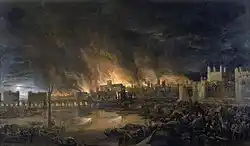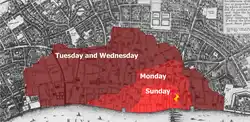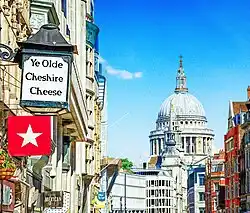
The Great Fire of London was a major urban fire which destroyed huge parts of the city of London between the 2nd and 6th of September 1666. The fire is understood to have begun in a bakery on Pudding Lane in the city in the early hours of the 2nd. The fire’s impact was worsened in the days that followed by strong winds which saw it spread across central London unchecked. Eventually the government had to simply let it burn itself out and for rain to arrive to quell the flames. By the time it was fully extinguished on the 6th of September well over half the ancient city within the walls was destroyed, along with over 13,000 homes and 87 churches, including St Paul’s Cathedral and parts of the old Roman walls of Londinium. The death toll was comparatively limited by comparison with the wider damage, but a huge proportion of the city’s population was left homeless. London recovered quickly as an extensive building programme commenced.[1]
Chronology of events during the Great Fire of LondonChronology of events during the Great Fire of London
London, the capital of England, has more of a storied history in the early modern period than most other cities in Europe during the sixteenth and seventeenth centuries. At the beginning of the period in 1500 it was little more than a town by modern standards, with a population of approximately 50,000 people. Yet it was England’s capital and the seat of government was also nearby up the River Thames at Westminster. It was also at the heart of England’s growing trade and colonial activity. As a result, it grew exponentially to a city of as many as 200,000 people by 1600, 350,000 by 1650 and over half a million by 1700.[2] During those same centuries it became home to companies such as the English East India Company that would come to dominate large parts of the globe, while in January 1649 King Charles I was executed at Westminster by the English parliament in an important development in European political history and the shift from monarchy to democracy.[3][4]
The Great Fire of London was one of the most striking episodes within this colorful history of early modern London. Shortly after midnight on the 2nd of September 1666, a small fire broke out in the home of a baker on Pudding Lane a stone’s throw from London Bridge and a brisk five minute walk away from the Tower of London. Cities were only just then beginning to consider the idea of dedicated fire services. The embryonic version of it soon showed up to the blaze along with the Lord Mayor of London, Sir Thomas Bloodworth.[5] This was the critical moment in events. The standard method of stopping an urban blaze in early modern times was to pull down the buildings around it and so stopping the spread. This might seem like a drastic measure, but remember that houses in those days were built out of timber and other substances which meant that a bad urban fire could spread quickly and cause havoc. However, Bloodworth owned some of the neighboring properties and told the fire-crews not to pull the buildings down and let the blaze die out. It was a dreadful decision in hindsight.[6]

The fire began to spread in the morning of the 2nd of September and by that afternoon was out of control, as heavy winds spread it far and wide into the adjoining streets. By the evening King Charles II and his brother, the Duke of York, sailed down river form Westminster to get a closer look at what was happening. Although they ordered measures to be taken at that juncture, there was nothing could be done by that time to stop it. Early modern people did not have helicopters to fly over and dump vast quantities of water on it, or fire hydrants to spray it with a small ocean of water. Instead they had to wait for the rain to come. It took four days for it to arrive and the fire burned until the 6th of September.[7]
By then over half of the old city within what had been the Roman walls was destroyed, as well as substantial regions in the city as it had expanded west of the old walls along what is now the Strand in London. Over 13,000 buildings were destroyed, 87 churches, important buildings such as the Royal Exchange and the central point of the entire city, St Paul’s Cathedral[1].
Extent of migration associated with the Great Fire of LondonExtent of migration associated with the Great Fire of London

The Great Fire left tens of thousands of people homeless and with it having occurred in the middle of the autumn, many people spent the winter of 1666 living in tents and other temporary accommodation near London. This was a particularly grueling experience as Europe at the time was going through the very height of the Little Ice Age, a period of extremely cold weather in early modern times which peaked in the seventeenth century causing dreadful famines. The suffering was compounded as London had only just recently experienced a vicious outbreak of the bubonic plague, one which had killed tens of thousands of people in 1664 and 1665.[8] Despite all of this, London continued to experience the level of net inward migration from other parts of England which had been occurring for a century by that time. Many people were drawn by the reconstruction work which was available in the late 1660s and early 1670s as homes were rebuilt and major construction projects such as Christopher Wren’s new St Paul’s Cathedral were undertaken.[9]
Demographic impact of the Great Fire of LondonDemographic impact of the Great Fire of London
The demographic impact of the Great Fire was limited. In the short run, it did lead to numerous deaths. Many of these were of the city’s poor and with imprecise municipal records at the time, many went unrecorded. That said, the level of mortality in no way matched the physical destruction and most people were evacuated from the city before the city claimed their homes and businesses. In the aftermath of it London continued to experience growth, after the immediate shock of having to rebuild. By 1700 the city’s population had surpassed half a million people. It grew to 700,000 by 1750 and reached a million souls before 1800, becoming the largest city in the world in the nineteenth century.[10]
See alsoSee also
Explore more about the Great Fire of LondonExplore more about the Great Fire of London
- England Births and Christenings, 1538-1975 record collection MyHeritage
- England Marriages, 1538-1973 record collection on MyHeritage
- England and Wales, Hearth Tax, 1662-1674 record collection on MyHeritage
- England Deaths and Burials, 1538-1991 record collection on MyHeritage
- Uncovering the lives of your London (England) ancestors at Legacy Family Tree Webinars
References
- ↑ 1.0 1.1 The Great Fire of London. London Fire Brigade
- ↑ Open City: London, 1500–1700. Folgerpedia
- ↑ The Execution of Charles I. History Today
- ↑ Historian Explores the Impact of Royal Execution. Herefordshire & Worcestershire Chamber of Commerce
- ↑ Sir Thomas Bloodworth and the Great Fire of London: Villain or Scapegoat?. Owlcation
- ↑ The Great Fire of London. Historic UK
- ↑ When London Burned: 1666’s Great Fire. History Channel
- ↑ Great Plague of 1665-1666. The National Archives
- ↑ The rebuilding of St.Paul’s Cathedral after the Great Fire of London. The history of London
- ↑ A Population History of London. The proceedings of the Old Bailey

